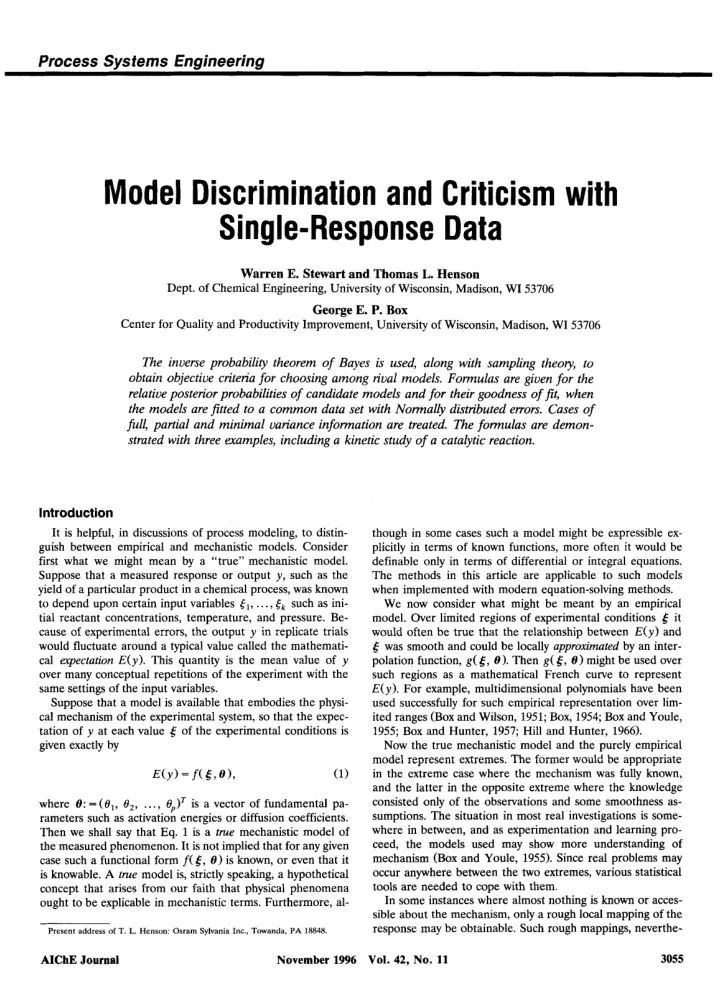

Single-Response Data zyxwvutsrqponmlkjihgfedcbaZYXWVUTSRQPONMLKJIHGFEDCBA Process Systems Engineering zyxwvutsrqponmlkjihgfedcbaZYXWVUTSRQPONMLKJIHGFEDCBA Warren E. Stewart and Thomas L. Henson zyxwvutsrqponmlkjihgfedcbaZYXWVUTSRQPONMLKJIHGFEDCBA Model Discrimination and Criticism with Center for Quality and Productivity Improvement, University of Wisconsin, Madison, WI 53706 zyxwvutsrqponmlkjihgfedcbaZYXWVUTSRQPONMLKJIHGFEDCBA obtain objective criteria zyxwvutsrqponmlkjihgfedcbaZYXWVUTSRQPONMLKJIHGFEDCBA probabilities of candidate models and for their goodness of zyxwvutsrqponmlkjihgfedcbaZYXWVUTSRQPONMLKJIHGFEDCBA Dept. of Chemical Engineering, University of Wisconsin, Madison, WI 53706 George E. P. Box The inverse probability theorem of Bayes is used, along with sampling theory, to for choosing among riual models. Formulas are given for the relative posterior fit, when the models are fitted to a common data set with Normally distributed errors. Cases of full, partial and minimal variance information are treated. The formulas are demon- to depend upon certain input variables tl, zyxwvutsrqponmlkjihgfedcbaZYXWVUTSRQPONMLKJIHGFEDCBA strated with three examples, including a kinetic study of a catalytic reaction. Introduction It is helpful, in discussions of process modeling, to distin- though in some cases such a model might be expressible ex- polation function, zyxwvutsrqponmlkjihgfedcbaZYXWVUTSRQPONMLKJIHGFEDCBA guish between empirical and mechanistic models. Consider plicitly in terms of known functions, more often it would be first what we might mean by a “true” mechanistic model. definable only in terms of differential or integral equations. Suppose that a measured response or output y , such as the The methods in this article are applicable to such models yield of a particular product in a chemical process, was known when implemented with modern equation-solving methods. . . . tk , such as ini- We now consider what might be meant by an empirical model. Over limited regions of experimental conditions & it tial reactant concentrations, temperature, and pressure. Be- cause of experimental errors, the output y in replicate trials would often be true that the relationship between E ( y ) and =(el, zyxwvutsrqponmlkjihgfedcbaZYXWVUTSRQPONMLKJIHGFEDCBA would fluctuate around a typical value called the mathemati- 5 was smooth and could be locally approximated by an inter- g( &, 0). Then g( &, 0) cal expectation E(y). This quantity is the mean value of y might be used over over many conceptual repetitions of the experiment with the such regions as a mathematical French curve to represent same settings of the input variables. y ). For example, multidimensional polynomials have been E( Suppose that a model is available that embodies the physi- used successfully for such empirical representation over lim- cal mechanism of the experimental system, so that the expec- ited ranges (Box and Wilson, 1951; Box, 1954; Box and Youle, tation of y at each value 6 of the experimental conditions is 1955; Box and Hunter, 1957; Hill and Hunter, 1966). given exactly by Now the true mechanistic model and the purely empirical model represent extremes. The former would be appropriate in the extreme case where the mechanism was fully known, and the latter in the opposite extreme where the knowledge ..., 8 consisted only of the observations and some smoothness as- where 0: is a vector of fundamental pa- 8 , , , ‘ ) sumptions. The situation in most real investigations is some- rameters such as activation energies or diffusion coefficients. where in between, and as experimentation and learning pro- Then we shall say that Eq. 1 is a tme mechanistic model of ceed, the models used may show more understanding of the measured phenomenon. It is not implied that for any given &, 0) is known, or even that it mechanism (Box and Youle, 1955). Since real problems may case such a functional form f ( occur anywhere between the two extremes, various statistical is knowable. A true model is, strictly speaking, a hypothetical tools are needed to cope with them. concept that arises from our faith that physical phenomena In some instances where almost nothing is known or acces- ought to be explicable in mechanistic terms. Furthermore, al- sible about the mechanism, only a rough local mapping of the response may be obtainable. Such rough mappings, neverthe- T. L. Henson: Osram Sylvania Inc., Towanda, PA 18848. Present address of AIChE Journal November 1996 Vol. 42, No. 11 3055
Recommend
More recommend